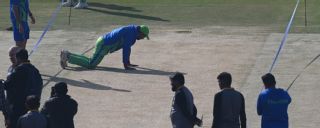|
You know the initial feeling of disquiet when you move back home after a few years away? It's the unfamiliarity of surroundings that should, in theory, feel perfectly natural, and yet there's enough that's ever so slightly off to refuse to allow your brain to truly relax. Perhaps the TV in the living room isn't working, maybe the comfortable leather chair isn't where you left it. None of it is especially offensive, but you know there are matters to be tended to before all systems are up and running, and you can truly feel comfortable. Perhaps you've returned home from university, or work in another city. Or perhaps, like the Pakistan cricket team, you were forced away from home for a decade owing to issues well beyond your control. The response to last week's limp defeat against England, though, reveals how unfamiliar Pakistan still feels to this, well, Pakistan side. Babar Azam had criticised the Rawalpindi surface for failing to meet the home side's expectations, but said he expected the Multan pitch to take a lot more spin. "It looks as if it'll be a turning wicket," Babar said. "The wicket is dry, and the way it's behaving, I feel it'll help both spin and reverse swing. Our main focus is on the spinners though, and that's what we're looking to utilise." This could have been Misbah-ul-Haq from a few years ago, talking about Abu Dhabi rather than Multan. But the foundation upon which Misbah's game plans were set are a lot less established for Babar's Pakistan side. For one, it remains unclear whether South Punjab's watery winter sunshine can produce the same wicket the UAE's baking heat would have allowed. Misbah's utilsation of his spin attack was immaculate, as was his near-perfect clarity of thought about what he wanted out of his Test side in the UAE. Whether it's conditions or tactical nous, Babar is still a fair way away from matching that. Even if he did, though, it isn't immediately obvious that quality spin is Pakistan's competitive advantage over England. Zahid Mahmood conceded more runs on debut last week than any bowler in history and his first-class form doesn't suggest much different. Abrar Ahmed, though impressive in the first-class Quaid-e-Azam Trophy, is yet to make his debut, with allrounder Mohammad Nawaz the left-arm option. Sajid Khan and Nauman Ali, the two spinners Pakistan used against Australia, struggled to have an impact, and there's little to follow after them that might indicate the bounties of the UAE era are anywhere close to imminent.  By contrast, England's leading spinner Jack Leach has played twice as many Tests as all three combined, and is two wickets away from 100 Test wickets. He has operated as England's lead spinner in the West Indies, Australia, India and Sri Lanka, and took ten wickets in a Test in a recent series win at home over New Zealand. He took the final wicket under the setting sun in Rawalpindi last week. If Pakistan do indeed get the pitch they're after, there's little to indicate Leach wouldn't be the biggest beneficiary.
By contrast, England's leading spinner Jack Leach has played twice as many Tests as all three combined, and is two wickets away from 100 Test wickets. He has operated as England's lead spinner in the West Indies, Australia, India and Sri Lanka, and took ten wickets in a Test in a recent series win at home over New Zealand. He took the final wicket under the setting sun in Rawalpindi last week. If Pakistan do indeed get the pitch they're after, there's little to indicate Leach wouldn't be the biggest beneficiary.
A turning pitch might of course serve as a carapace against the destructive power of England's batting line-up, levelling the playing surface by making attacking shots even more high-risk. But Pakistan haven't yet created a home template they can be comfortable with, and the security blanket of what their predecessors did in the UAE is too tempting not to reach for. The insecurity is perhaps natural for a side that hasn't yet established a clear Test identity like Misbah's UAE team did, as is the desire to try and recreate the only successful template this crop of Pakistan players has seen. Having been supremely successful in building a home away from home, Pakistan seem to be struggling to recall what they enjoyed about home in the first place, in the years before 2009, before circumstances pushed them out into the Arabian desert. It might be down to the youth of this side; no one from Pakistan's current squad played international cricket in Pakistan before 2009. As such, there's little to fall back on when Pakistan need to return to basics, as they might feel they do now after four winless home Tests; there was never a longer barren streak during Pakistan's entire time in the UAE. What this generation of Pakistan players do understand is what worked in the UAE, and the staggering success Misbah's side enjoyed in a country that held little for Pakistan's most prized skill: fast bowling. They will remember, instead, how Misbah weaponised a template that let loose Saeed Ajmal and later Yasir Shah, two of the most prolific spinners in the generation just gone. They will recall the multiple series wins against England, the outstmarting of South Africa and the hammering of the Australians. It became Pakistan's brand, the new normal. Pakistan's fast bowling suffered as a result but while they didn't lose a "home" series for seven years, there was enough paper to go round to cover the cracks. But time at university or work invariably draws to a close, and then home beckons. For Pakistan, that should have been a moment for uncomplicated joy given the circumstances that drove them out. But on the field, it was a little more complicated. Having spent most of their emotional energy ensuring they got back home, the idea of what they might do once they got there was rather more nebulous. A tidal wave of emotion, and the fact a relatively feeble Sri Lanka and Bangladesh were the first two touring sides, ensured Pakistan won the two Tests it was realistically possible to get a result in (the first Test against Sri Lanka was weather-impacted). Naseem Shah took a five-for in one Test, a hat-trick in another. Shaheen Afridi and Mohammad Abbas complemented each other and found wickets, while Azhar Ali tactfully spoke of Yasir Shah's "changing" (read: diminished) role in the side. When South Africa, the first real Test at home arrived, Pakistan found themselves at their best. Hasan Ali timed his purple patch perfectly to run through the visitors at crucial times, with Afridi at his effervescent best. The surfaces were designed to produce results, and both matches did - Pakistan triumphing each time. But Pakistan were also a team in transition and, again, victories can be especially effective at masking bumps in the road. Yasir's plummeting form and off-field problems began to reveal how bereft Pakistan's spin depth actually was, with the leading spinners in the Quaid-e-Azam Trophy looking palpably out of their depth when summoned to the national side. That this volte-face should happen in Multan - a city that's hosted so little Test cricket that it would feel unfamiliar to even the most seasoned Test cricketers - is perhaps apt for a Pakistan side who might have returned to Pakistan a few years ago, but are still figuring out how to feel at home.
|

